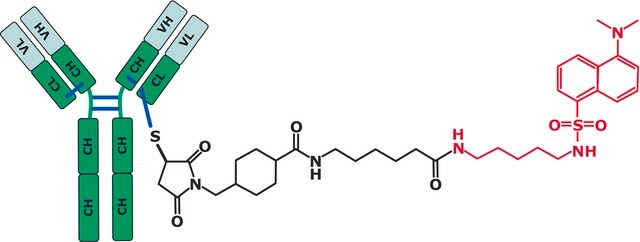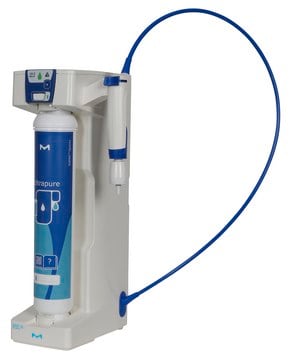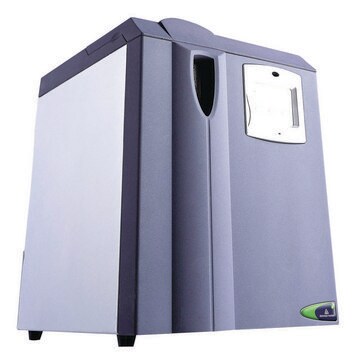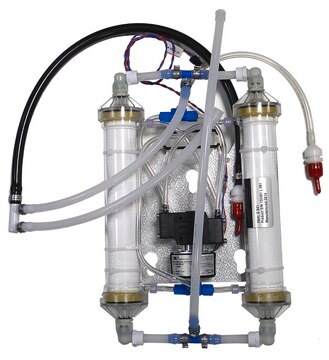推荐产品
生物源
mouse
品質等級
抗體表格
purified antibody
抗體產品種類
primary antibodies
無性繁殖
H11, monoclonal
物種活性
mouse
物種活性(以同源性預測)
human (based on 100% sequence homology)
技術
immunocytochemistry: suitable
immunohistochemistry: suitable
western blot: suitable
同型
IgG1κ
NCBI登錄號
UniProt登錄號
運輸包裝
wet ice
目標翻譯後修改
unmodified
基因資訊
human ... GPR56(9289)
一般說明
G蛋白偶联受体56(GPR56)是一种普遍存在的粘附受体,属于G蛋白偶联受体2家族和LN-TM7亚家族。它在甲状腺、脑、心脏和各种肿瘤细胞中大量表达。先前的研究表明,GPR56可能通过与细胞外基质蛋白(例如组织转谷氨酰胺酶)相互作用来抑制黑色素瘤的进展和转移。GPR56还通过PKCα介导的途径在调节VEGF的产生和血管生成中发挥作用。GPR56在额叶皮层的发育中也起着至关重要的作用。先前的研究报道,GPR56中的突变会导致皮层分层紊乱,这在额叶皮层中最为明显。这种情况被称为双侧额顶多小脑回畸形或BFPP。
免疫原
小鼠GPR56的N末端片段
應用
免疫组织化学分析:一个代表性批次已被独立实验室用于小鼠脑组织。(Luo,R.,et al.(2011).Proc Natl Acad Sci U S A. 108(31):12925-12930.)
免疫细胞化学分析: 一个代表性批次已被独立实验室用于脑膜成纤维细胞(MF)。(Luo,R.,et al.(2011).Proc Natl Acad Sci U S A. 108(31):12925-12930.)
免疫细胞化学分析: 一个代表性批次已被独立实验室用于脑膜成纤维细胞(MF)。(Luo,R.,et al.(2011).Proc Natl Acad Sci U S A. 108(31):12925-12930.)
研究子类别
粘附(CAMs)
粘附(CAMs)
研究类别
神经科学
神经科学
该抗G蛋白偶联受体56(GPR56)抗体(克隆H11)经验证可用于蛋白质印迹、ICC、IHC检测G蛋白偶联受体56(GPR56)。
品質
通过蛋白质印迹法在E13-E14小鼠的脑组织裂解物中进行评估。
蛋白质印迹分析:0.5 μg/mL的该抗体在10µg E13-E14小鼠的脑组织裂解物中检测到G-蛋白偶联受体56。
蛋白质印迹分析:0.5 μg/mL的该抗体在10µg E13-E14小鼠的脑组织裂解物中检测到G-蛋白偶联受体56。
標靶描述
观测分子量〜62 kDa。全长GPR56(GPR56FL)以75 kDa迁移,而GPR56的裂解胞外域(GPR56ECD)以62 kDa迁移(J Biol Chem. 2008 May 23;283(21):14469-78)。
外觀
形式:纯化
纯化的小鼠单克隆IgG1κ,溶于含0.1 M Tris-甘氨酸(pH 7.4)、150 mM NaCl和0.05%叠氮化钠的缓冲液中。
纯化蛋白G
儲存和穩定性
自接收之日起,在2-8°C下可稳定保存1年。
分析報告
对照
来自E13-E14小鼠的脑组织裂解物
来自E13-E14小鼠的脑组织裂解物
其他說明
浓度:关于批次特定浓度请参见检验报告。
免責聲明
除非我们的目录或产品随附的其他公司文件中另有说明,否则我们的产品预期仅用于研究用途,不得用于任何其他目的,包括但不限于未经授权的商业用途、体外诊断用途、离体或体内治疗用途或对人类或动物的任何类型的消费或应用。
未找到合适的产品?
试试我们的产品选型工具.
儲存類別代碼
12 - Non Combustible Liquids
水污染物質分類(WGK)
WGK 1
閃點(°F)
Not applicable
閃點(°C)
Not applicable
D Daria et al.
Leukemia, 30(8), 1734-1741 (2016-04-12)
The G protein-coupled receptor 56 (GPR56) was identified as part of the molecular signature of functionally validated leukemic stem cells isolated from patients with acute myeloid leukemia (AML). This report now demonstrates particularly high expression of GPR56 in patients with
Oladapo E Olaniru et al.
Molecular metabolism, 53, 101285-101285 (2021-07-06)
Members of the adhesion G protein-coupled receptor (aGPCR) subfamily are important actors in metabolic processes, with GPR56 (ADGRG1) emerging as a possible target for type 2 diabetes therapy. GPR56 can be activated by collagen III, its endogenous ligand, and by
Gabriel S Salzman et al.
Proceedings of the National Academy of Sciences of the United States of America, 114(38), 10095-10100 (2017-09-07)
Adhesion G protein-coupled receptors (aGPCRs) play critical roles in diverse biological processes, including neurodevelopment and cancer progression. aGPCRs are characterized by large and diverse extracellular regions (ECRs) that are autoproteolytically cleaved from their membrane-embedded signaling domains. Although ECRs regulate receptor
Ayako Y Murayama et al.
Scientific reports, 10(1), 21516-21516 (2020-12-11)
GPR56, a member of the adhesion G protein-coupled receptor family, is abundantly expressed in cells of the developing cerebral cortex, including neural progenitor cells and developing neurons. The human GPR56 gene has multiple presumptive promoters that drive the expression of
Shih-Chia Huang et al.
EMBO molecular medicine, 9(12), 1660-1680 (2017-10-11)
Lymph node (LN) metastasis is commonly associated with systemic distant organ metastasis in human breast cancer and is an important prognostic predictor for survival of breast cancer patients. However, whether tumor-draining LNs (TDLNs) play a significant role in modulating the
我们的科学家团队拥有各种研究领域经验,包括生命科学、材料科学、化学合成、色谱、分析及许多其他领域.
联系技术服务部门








